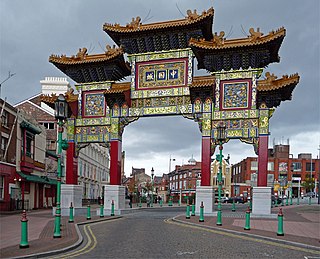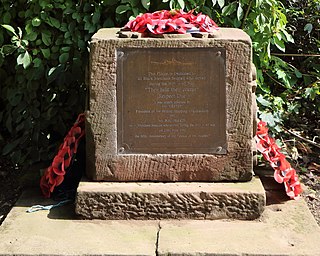
Sefton Park is a public park in south Liverpool, England. The park is in a district of the same name, located roughly within the historic bounds of the large area of Toxteth Park. Neighbouring districts include modern-day Toxteth, Aigburth, Mossley Hill, Wavertree and St Michael's Hamlet.

The Hall of Memory is a war memorial in Centenary Square, Birmingham, England, designed by S. N. Cooke and W. N. Twist. Erected 1922–25 by John Barnsley and Son, it commemorates the 12,320 Birmingham citizens who died in World War I.

Gambier Terrace is a street of 19th-century houses overlooking St. James's Mount and Gardens and Liverpool Cathedral. It is generally reckoned to be in Canning, although it falls within the Rodney Street conservation area, together with Hope Street and Rodney Street.

Albert Square is a public square in the centre of Manchester, England. It is dominated by its largest building, the Grade I listed Manchester Town Hall, a Victorian Gothic building by Alfred Waterhouse. Other smaller buildings from the same period surround it, many of which are listed.

Greenbank Park is a public park in Liverpool, England, with the middle of the park dominated by a large pond. It is situated in the suburb of Mossley Hill in the south of the city, close to Penny Lane and Sefton Park.

St John's Gardens is an open space in Liverpool, England, to the west of St George's Hall. The gardens are part of the William Brown Street conservation area, and comprise one of the two open spaces within Liverpool's World Heritage Site. It has been a Green Flag site since 2003. The gardens contain ornamental flower beds, and memorials to notable people of the city.

Anfield Cemetery, or the City of Liverpool Cemetery, is located in Anfield, a district of Liverpool, Merseyside, England. It lies to the northeast of Stanley Park, and is bounded by Walton Lane to the west, Priory Road to the south, a railway line to the north, and the gardens of houses on Ince Avenue to the east. The cemetery grounds are included in the National Register of Historic Parks and Gardens at Grade II*.

The Cholera Monument is a memorial in Sheffield, England, to the victims of a cholera epidemic of 1832. Of the 402 victims of the disease 339 were buried in grounds between Park Hill and Norfolk Park adjoining Clay Wood. Money from the treasurers of the Board of Health was set aside for a monument for the site.

Old Square is a public square and road junction in the Core area of Birmingham City Centre, England.

Dodds Township is one of sixteen townships in Jefferson County, Illinois, USA. As of the 2010 census, its population was 2,647 and it contained 1,163 housing units.

Chinatown is an area of Liverpool that is an ethnic enclave home to the oldest Chinese community in Europe. Located in the south of the city centre, Chinatown has many Chinese businesses, such as Chinese restaurants and supermarkets, and facilities for the Chinese community. The area is also notable for its Chinese-style architecture; with the paifang on Nelson Street being the largest, multiple-span arch of its kind outside China.
Reynolds Park is a 14-acre (57,000 m2) park in Woolton, Liverpool. The origins of the park are 200 years ago, it was bequeathed to the City Council in 1926.
Liverpool is a city and port in Merseyside, England, which contains many listed buildings. A listed building is a structure designated by English Heritage of being of architectural and/or of historical importance and, as such, is included in the National Heritage List for England. There are three grades of listing, according to the degree of importance of the structure. Grade I includes those buildings that are of "exceptional interest, sometimes considered to be internationally important"; the buildings in Grade II* are "particularly important buildings of more than special interest"; and those in Grade II are "nationally important and of special interest". Very few buildings are included in Grade I — only 2.5% of the total. Grade II* buildings represent 5.5% of the total, while the great majority, 92%, are included in Grade II.
West Derby is a Liverpool City Council ward within the Liverpool West Derby Parliamentary constituency. It was formed for the 2004 Municipal elections comprising most of the pre-2004 Croxteth ward, incorporating small parts of Gilmoss and Broadgreen wards.

Llanfechell is a village in Anglesey, Wales. It is the largest of several small villages and dispersed settlements that make up Mechell Community Council area. It is 11 miles (18 km) east of Holyhead, and 5.6 miles (9 km) west of Amlwch, in the north of the island.

Grant Gardens previously Liverpool Necropolis, is a park and former cemetery in Liverpool, United Kingdom. It is named after Alderman J. R. Grant, J.P, chairman of the Corporation Parks and Gardens Committee.

Grosvenor Gardens is the name given to two triangular parks in Belgravia, London, faced on their western and eastern sides by streets of the same name. Both roads run roughly north to south from Hobart Place and Grosvenor Place to Buckingham Palace Road.

Picton Clock Tower is a 19th-century Grade II listed clock tower located in Wavertree, Liverpool, England. Built in 1884 and designed by James Picton, the tower is a memorial to the architect's wife Sarah Pooley, who had died in 1879.

Falkner Street is a street mostly in Canning, with a short section in Edge Hill, Liverpool, England. The street, built during the early-mid 19th century, is named after Edward Falkner, who had previously commissioned the construction Falkner Square. Constructed at a time when Liverpool had less than 100,000 houses, the Falkner Street houses sold for around £1,000 and were affordable to only the wealthiest 1% of the population.

The Black Merchant Seamen War Memorial is a sandstone stone memorial, It is situated in Falkner Square, Liverpool. The stone is from the Liverpool Seamen's Hostel with a bronze plaque dedicated to all the Black Seamen who served during World War II. It was unveiled in 1993 on the 50th anniversary of the Battle of the Atlantic.

















